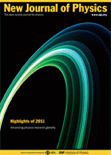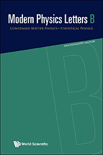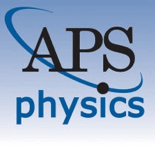
NEW JOURNAL OF PHYSICS
Scope & Guideline
Bridging theory and practice in contemporary physics.
Introduction
Aims and Scopes
- Quantum Physics and Information:
A central theme in the journal, this area explores quantum mechanics, quantum information theory, and quantum computing, including studies on entanglement, quantum key distribution, and quantum algorithms. - Condensed Matter Physics:
This encompasses research on the properties of solid-state materials, phase transitions, and emergent phenomena in condensed matter systems, including studies on superconductivity, magnetism, and topological phases. - Optics and Photonics:
Research in this area involves the interaction of light with matter, including laser physics, nonlinear optics, and applications of photonic crystals and metamaterials. - Statistical Physics and Thermodynamics:
This area includes studies on non-equilibrium dynamics, thermodynamic properties of systems, and statistical mechanics principles applied to complex systems. - Nanotechnology and Materials Science:
The journal publishes research on the synthesis, characterization, and application of nanomaterials, including their electronic, optical, and mechanical properties. - Interdisciplinary Applications:
Research that bridges physics with other fields such as biology, chemistry, and engineering is highlighted, emphasizing the relevance of physics in solving real-world problems.
Trending and Emerging
- Quantum Technologies:
There is a notable increase in research related to quantum technologies, including quantum computing, quantum cryptography, and quantum metrology, driven by advancements in experimental techniques and theoretical frameworks. - Topological Materials and Phases:
Research on topological materials, including topological insulators and semimetals, has gained significant traction, reflecting the broader interest in their unique electronic properties and potential applications. - Active Matter and Non-Equilibrium Systems:
Studies focusing on active matter systems, which exhibit self-propulsion and collective behavior, are emerging as a vibrant area of research, particularly in understanding biological systems and synthetic materials. - Machine Learning and Artificial Intelligence Applications:
The integration of machine learning techniques in physics research for data analysis, modeling, and optimization has become increasingly popular, showcasing the interdisciplinary nature of modern physics research. - Graph Theory and Network Science:
There is a growing interest in applying graph theory and network science to understand complex systems, particularly in the context of social networks, biological systems, and transport phenomena.
Declining or Waning
- Classical Mechanics and Fluid Dynamics:
Research in classical mechanics and fluid dynamics has become less prominent, likely due to the increasing interest in quantum mechanics and complex systems that exhibit non-classical behavior. - Basic Electromagnetic Theory:
Papers focusing solely on traditional electromagnetic theory have decreased, as researchers tend to explore more complex phenomena that incorporate quantum effects or materials science. - Traditional Thermodynamics:
Studies centered around classical thermodynamics without a quantum or statistical context are less frequently published, indicating a shift towards more modern interpretations of thermodynamic principles. - Basic Particle Physics:
Research purely focused on particle physics without interdisciplinary applications or connections to condensed matter physics has seen a decline, as the field becomes increasingly integrated with other areas, such as quantum field theory.
Similar Journals

Condensed Matter
Illuminating the Path of Condensed Matter StudiesCondensed Matter is a leading open-access journal dedicated to the diverse and dynamic field of condensed matter physics, published by MDPI since 2016. With its base in Switzerland, the journal aims to present a platform for researchers and professionals to share innovative findings and advancements in areas such as electronic, optical, and magnetic materials. As of 2023, it is ranked in the Q3 category for both condensed matter physics and electronic, optical, and magnetic materials, a testament to its relevance and growth within the scientific community. Researchers will find valuable insights through its accessible format, fostering collaboration and knowledge dissemination within this interdisciplinary field. With a commitment to enhancing the global dialogue in condensed matter studies, Condensed Matter invites contributions that explore theoretical and experimental approaches, thus pushing the boundaries of understanding in this crucial area of science.

MODERN PHYSICS LETTERS B
Fostering a vibrant community of physics researchers and thinkers.MODERN PHYSICS LETTERS B, published by World Scientific Publishing Co Pte Ltd, is a pivotal journal in the fields of Condensed Matter Physics and Statistical and Nonlinear Physics. With an ISSN of 0217-9849 and an E-ISSN of 1793-6640, this journal has been a prominent platform for innovative physics research since its inception in 1996, catering to a global audience of researchers, professionals, and students alike. Its impact is reflected in its Scopus rankings, with a commendable position in the 65th percentile for Statistical and Nonlinear Physics and the 54th percentile for Condensed Matter Physics. Despite its classification in the Q3 quartile, MODERN PHYSICS LETTERS B is dedicated to advancing knowledge through rapid dissemination of high-quality research, thus playing a critical role in shaping future developments in its disciplines. Published in Singapore, the journal encourages contributions that address contemporary challenges and breakthroughs in physics, fostering an engaged scholarly community.

Science China-Physics Mechanics & Astronomy
Pioneering Research in Fundamental and Applied PhysicsScience China-Physics Mechanics & Astronomy, published by SCIENCE PRESS, stands as a prestigious journal within the Physics and Astronomy domain, particularly recognized for its contributions to the understanding of fundamental and applied physics. With an exhilarating Q1 ranking in the 2023 category and earning a remarkable scopus rank of #21 out of 243, the journal demonstrates its significant impact, being positioned in the 91st percentile of its field. Operating under an Open Access model, it facilitates the broad dissemination of high-quality research, ensuring accessibility for researchers, professionals, and students worldwide. Its scope covers a variety of essential topics in physics and astronomy, promoting a comprehensive understanding of the latest advancements from 2010 through 2024. The journal is a vital resource for anyone aiming to stay at the forefront of research in these dynamic fields, with its prominent address located in Beijing, China, symbolizing its global influence.

JOURNAL OF STATISTICAL PHYSICS
Connecting researchers to the pulse of Statistical Physics.The Journal of Statistical Physics, published by Springer, is a premier academic journal that has made significant contributions to the fields of Mathematical Physics and Statistical and Nonlinear Physics since its inception in 1969. With a strong reputation reflected in its 2023 rankings—placing it in Q2 of both categories and achieving an impressive Scopus rank of #22 in Mathematical Physics and #25 in Statistical and Nonlinear Physics—this journal serves as a vital platform for researchers, professionals, and students. The impact factor of the journal underscores its importance in disseminating cutting-edge research and theoretical developments. Authors are invited to submit original research articles that explore the intricate complexities of statistical mechanics, quantum physics, and related disciplines, fostering deep insights and academic discourse. Although the journal does not currently offer open access, its robust editorial standards and commitment to advancing knowledge make it an essential resource for those engaged in these dynamic fields.

INDIAN JOURNAL OF PHYSICS
Elevating Physics Discourse Across BordersINDIAN JOURNAL OF PHYSICS, published by the Indian Association for Cultivation of Science, serves as a pivotal platform for researchers and scholars in the field of physics and astronomy. With its ISSN 0973-1458 and E-ISSN 0974-9845, this journal is committed to presenting innovative research and developments across diverse topics in physics, covering both theoretical and experimental studies. The journal has made its mark in the academic community, evidenced by its classification in the Q3 category within the Physics and Astronomy domain as of 2023, and ranks #100 out of 243 in the Scopus curated database, placing it in the 59th percentile. Spanning from 2005 to 2024, the INDIAN JOURNAL OF PHYSICS aims to foster knowledge exchange and stimulate discussions among physicists and scientific enthusiasts. Whether you are a researcher looking to publish your findings, a professional seeking updates in your field, or a student eager to explore varying aspects of physics, this journal is an invaluable resource contributing significantly to the understanding and advancement of physics in India and beyond.

JETP LETTERS
Elevating Scientific Discourse in Physics and AstronomyJETP LETTERS, published by MAIK NAUKA/INTERPERIODICA/SPRINGER, is a prestigious journal in the field of physics and astronomy, which plays a pivotal role in disseminating groundbreaking research and innovative ideas since its inception in 1969. With an ISSN of 0021-3640 and an E-ISSN of 1090-6487, this journal aligns well with the interests of both seasoned researchers and emerging scholars, having achieved a 2023 category rank of Q3 for miscellaneous topics within physics and astronomy. Located in the United States at 233 SPRING ST, NEW YORK, NY 10013-1578, JETP LETTERS serves as a critical resource for its readership, offering exclusive insights and advancements across diverse areas of physics. While not open access, it hosts a collection of articles that refine theoretical approaches and experimental methods, providing both knowledge and inspiration to professionals and academics seeking to make impactful contributions to the scientific community. The journal’s quality is reflected in its Scopus ranking, where it stands at 39 out of 81 in the multidisciplinary category, placing it in the 52nd percentile, thus underscoring its significance and reliability as a scholarly outlet.

PHYSICAL REVIEW A
Elevating Understanding of Quantum PhenomenaPHYSICAL REVIEW A, published by the American Physical Society, is a leading journal in the field of Atomic and Molecular Physics and Optics, boasting a Q1 category ranking in its area for 2023. With an ISSN of 2469-9926 and an E-ISSN of 2469-9934, this journal plays a pivotal role in disseminating high-quality research findings, theories, and methodologies that shape current understanding and advancements in the discipline. Although not an open-access journal, it remains highly accessible to professionals and academia through institutional subscriptions. The journal's impactful contributions are evident from its Scopus rank of #70 out of 224 in the field, placing it in the 68th percentile for scholarly impact. As a hub of innovative research and a vital resource for both students and seasoned researchers alike, PHYSICAL REVIEW A remains essential for those seeking to stay abreast of breakthroughs in atomic and molecular studies, as well as optics and photonics.

EPL
Shaping Tomorrow's Physics Through Collaborative ResearchEPL, a prominent journal published by IOP Publishing Ltd, stands at the forefront of the field of Physics and Astronomy. With a history of impactful contributions stretching from 1986 to 2024, EPL serves as a dynamic platform for researchers to disseminate their pioneering findings and innovative ideas. The journal, with a current category ranking of Q2 among its peers and a competitive Scopus rank of #101 out of 243 in the general physics and astronomy category, reflects its substantial reputation and contribution to the scientific community. Although it operates under a traditional subscription model, EPL's reach is extensive, enabling access to a diverse readership that includes academicians, industry professionals, and students alike. By fostering interdisciplinary collaboration and promoting rigorous research, EPL continues to play a vital role in shaping the future of physics and astronomy.

CHINESE PHYSICS LETTERS
Advancing the Frontiers of Physics ResearchChinese Physics Letters is a prestigious journal published by IOP Publishing Ltd, based in the United Kingdom. Since its inception in 1984, the journal has served as a vital platform for disseminating impactful research in the field of physics, achieving a noteworthy Q1 ranking in the category of Physics and Astronomy (miscellaneous) as of 2023. Renowned for its rapid publication process, this journal is dedicated to providing a forum for high-quality, concise articles that address innovative theoretical and experimental findings relevant to both the academic community and industry practitioners. With an impressive Scopus rank of #52 out of 243, placing it in the 78th percentile, Chinese Physics Letters continues to influence the global physics landscape. Researchers, professionals, and students alike find this journal indispensable for staying abreast of the latest developments and trends in physics.

ANNALEN DER PHYSIK
Charting New Territories in Physics and AstronomyANNALEN DER PHYSIK, a prestigious journal published by WILEY-V C H VERLAG GMBH, stands as a cornerstone of the field of physics and astronomy since its inception in 1799. With an ISSN of 0003-3804 and an E-ISSN of 1521-3889, this journal provides a platform for innovative research and critical discourse across various domains of physics. Annalen der Physik is currently ranked in the Q2 category for general physics and astronomy, occupying rank #76 out of 243 in Scopus, placing it within the 68th percentile. This indicates its significant impact and the quality of research it publishes. Although the journal does not offer Open Access options, its robust historical lineage and ongoing contributions ensure that it continues to be an essential resource for researchers, professionals, and students alike. For those seeking to stay at the forefront of contemporary physics research, ANNALEN DER PHYSIK represents a vital source of knowledge, innovation, and scholarly communication.